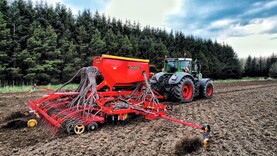Ground conditions: All areas of the country received a considerable amount of rain in October to date. Most tillage areas got between 50mm and 70mm. Some areas such as Johnstown Castle, Moorepark, Oak Park and Dublin Airport have now received between 75% and 80% of their 30-year mean, while many other areas are above 85%. Hopefully this means less rain to fall in most areas to the end of the year.
Planting: Planting progress has been good up to the start of this week, with many growers finished and most of the work done in good conditions and rolled. One-pass systems continue to work on freshly ploughed ground but a few hours to dry out is useful when possible.
Air temperatures have dropped and they have pulled soil temperature to just below average for the time of year. This will slow germination and establishment from here on, which add to the challenges of later planting.
There may still be opportunities to get more acres planted. With ground getting wetter and colder, it is important to push up seed rates to compensate for the inevitable pressures that will come on establishment as planting conditions become more challenging. It is likely that crows and slugs will become bigger problems now too.
If you have recently sown crops consider putting down some slug traps to gauge numbers and activity. A simple trap would involve some Alpen as bait, placed beneath a piece of carpet or an inverted flowerpot base. Do not use pellets as bait. Inspect the traps after a day or two to gauge activity and apply pellets where slugs are active.
All pests become more problematic as air and soil temperatures drop. Crop growth is slower and alternative food is less plentiful so crow and rabbit damage is also more likely. Crops take longer to establish and crows get bolder as they get hungrier.
There is still time to plant all winter cereals. It is more about ground conditions and field suitability. Barley crops planted now need good fertility while wheat and oats are less fussy. Plant conventional winter barley at around 380 seeds/m² (185-205kg/ha for 50-55g seed) and hybrids at 100-115kg/ha to establish at least 180 plants/m². Plant wheat at around 160-175kg/ha to establish over 280 plants/m² with 50g-55g seed. Plant oats at around 140-160kg/ha (35-40g seed) depending on seed size to establish 350 plants/m².
Aphids: Early sown crops will need an aphicide around the two- to three-leaf stage. In most instances this will be a pyrethroid at full rate but there are places where there are multiple resistance types in a local population.
If you have such a problem, consider using Teppeki as an alternative. It is much more expensive so it is only justifiable in high-risk situations where monitoring is helping to assess the risk. Application rate is 0.14kg/ha and it can be used on all cereals. Activity is both translaminar and systemic but it is unlikely to give protection of new growth.






 This is a subscriber-only article
This is a subscriber-only article









SHARING OPTIONS: